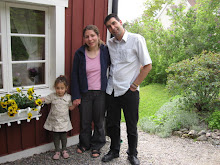



It has been really warm and sunny for the last 7-8 days, right after MidSommar, the summer weather spoil us every day and night. Temperature goes up to almost 30 degrees in the afternoon and close to 20 in the nights. This is perfect weather for taking the canoes, cross the lake on the other side and have nice bathings and lay on the little beach there.
As Swedes say it here, especially Leif, this weather is good for the potatoes!
BuBu is crazy about the water, she will stay in all day long. Last year at the seaside, she would scream only because some ball went in the sea...now she is screaming if we have to leave. such a huge progress).She wakes up in the morning and her first question is: "When do we go to the lake?". I think the potatoes are happy about it.
Huge event for us: Bzzz is here for a week, so BuBu is happy, Monica is very happy and i am even more because all three of them are happy. That's really good for the potatoes. We will be spending a nice time together, Bzzz can speak some romanian after 4 months (i mean more than talking with her family on the phone), visit some places and have fun with our swedish friends here.
Also, the volunteer team grew bigger here, we have new people that joined us at Kopparbo. So we met so far Markus, Henric, and recently Pia, Elin and Malin. More people here, more fun, more work that can be done, which is really good for the potatoes!
By the way, before the weather became so nice, we had 5 days only with rain and it was really cold, we barely saw some sun. But people here were smiling in the mornings and kept saying that the weather is good for the potatoes.
First few times we have been asking arround and try to understand why is it good for the potatoes. What is that special about them? And we understood that is just a nice way of accepting the weather like it is, there's nothing you can do about it so we'd rather do what we can do and do not complain.
Later on we realized that there are not even to many potatoes growing fields, they mostly import it from other countries because the land is not really good for them.
So, i think that even in the winter time, when the snow is half of a meter, Swedes would say that the weather is good for the potatoes.
Well, i think we have learned something new and useful which is very good for our potatoes!

















